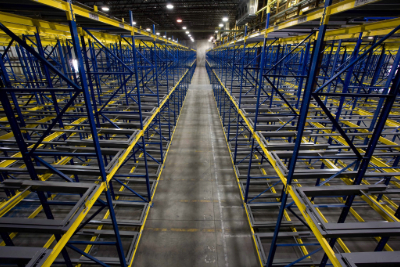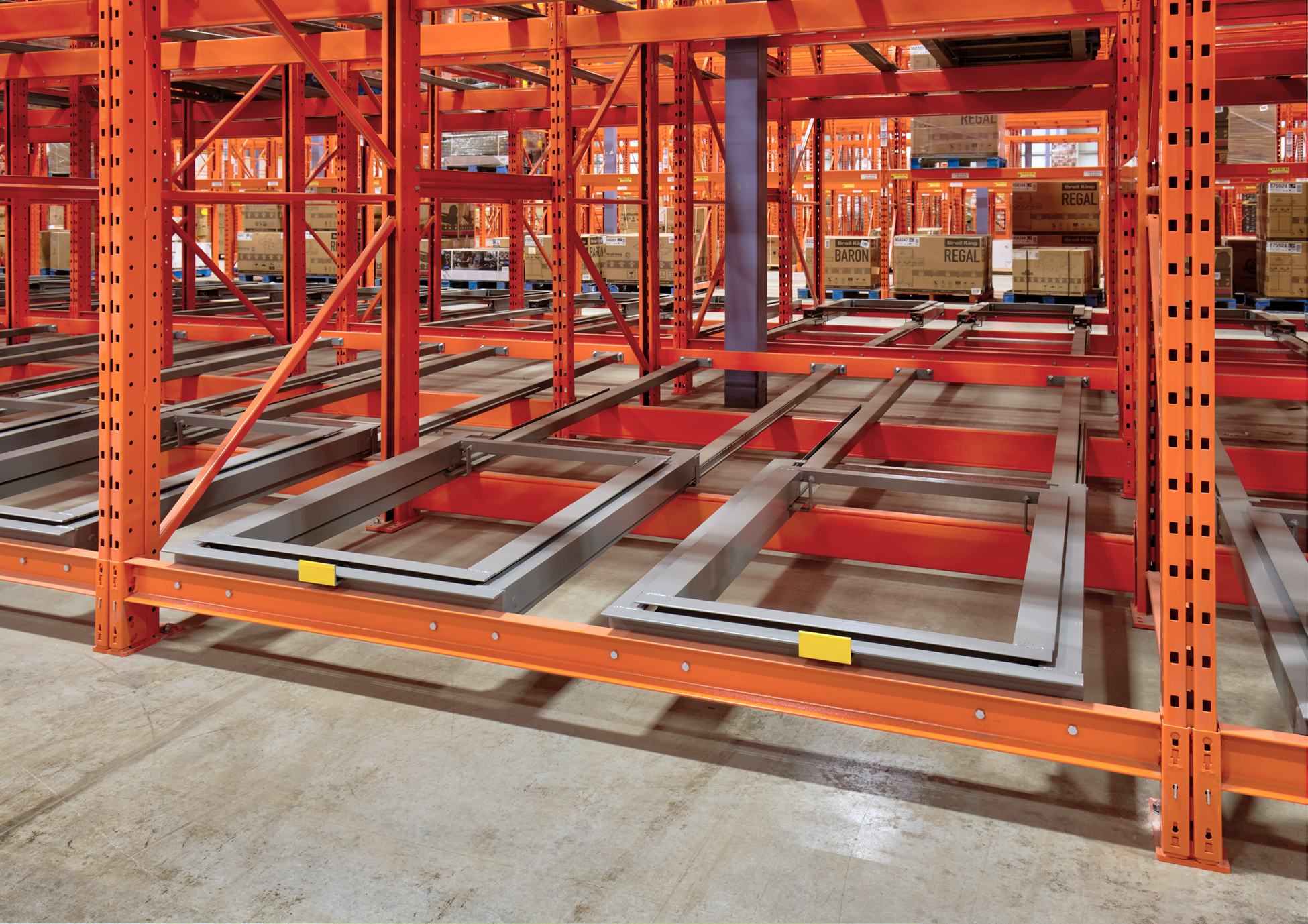Cold storage warehouses face unique storage challenges related to the cost of goods sold. Whether you store food, pharmaceuticals, or other climate-sensitive products, the demand for efficient storage is higher than ever. Beyond the critical need to maintain temperature conditions, your warehouse is missing out if you do not optimize your storage space. Pushback racking systems give you an industry advantage by ensuring efficiency, cost savings and product quality.
In this article, we will explore pushback racking systems, their different inventory management methods, such as FIFO and LIFO, and the many benefits of pushback racking for cold storage warehouses.
What Are Pushback Racking Systems?
Pushback racking systems provide a storage solution designed to maximize warehouse space. Our systems allow you to store multiple pallets in a single lane, each being pushed back as new pallets are added. This is called the Last-In-First-Out (LIFO) retrieval method, allowing you to maximize your warehouse space. However, you can quickly achieve First-In-First-Out (FIFO) by storing multiple product lanes (more on this later).
The 3D Storage pushback racking systems are constructed from structural steel that is designed to hold from 2-6 pallets deep. A pushback lane consists of nested carts sitting on top of a pair of inclined rails. The first pallet is loaded from the front, and it sits on the first (or top) cart. When the second pallet is loaded, it pushes the first pallet behind it back one position. This process continues for up to 6 pallets deep. To remove a pallet from the pushback rack, the forklift driver lifts the pallet off, reverses slowly, and the next pallet comes forward into the front position. This process is repeated until the lane is empty.
Check out our pushback racking system in action!
Space Optimization
Cold storage spaces are often at a premium due to the high cost of maintaining low temperatures. Pushback racking systems excel in space optimization by allowing multiple pallets to be stored within the same lane, thus reducing the number of aisles within the warehouse.
Pushback racking layouts can be as deep as 6 pallets deep – in a back-to-back configuration, this results in 12 pallets of storage between aisles. The ability to store more products within the same footprint not only improves storage capacity but also reduces the overall energy consumption of the facility.
By increasing density rather than floor space, you can save space or increase your overall warehouse inventory. This reduction in footprint results in lower energy consumption because the volume of warehouse space being cooled is minimized.
Improved Selectivity and Accessibility
While maximizing storage capacity is essential, easy access to stored goods is equally important. Pushback racking systems offer improved selectivity compared to traditional high-density storage systems like Drive-in racking. Each level can store a different SKU, and this means that goods can be easily accessed without having to empty an entire bay.
Enhanced selectivity is crucial in cold storage environments where inventory turnover is high. While each pushback lane is LIFO (last-in-first-out), by storing multiple lanes of the same product, FIFO (first-in-first-out) is easily achievable.
Learn about the differences between LIFO and FIFO systems.
How to achieve FIFO with pushback-racking
Pushback racking is considered a Last-In-First-Out (LIFO) retrieval system. However, with the food industry being one of the largest adopters of pushback racking, we know it is essential to achieve First-In-First-Out (FIFO) to prevent product spoilage. You can easily achieve FIFO in your cold storage warehouse by following these 4 steps:

Step #1 – Select Products to be stored that have at least 3 times the lane depth in average pallets in inventory.
Most storage facilities have products that range from one pallet per item up to many pallets per item. The average amount of storage per item should be used to determine optimal lane depth. The table shown below will yield occupancy rates of 80%-90%. The higher the number of lanes per product, the higher the occupancy rate.
| Pallets per Product | Lane depth |
| 1-4 | Standard Rack |
| 5-8 | 2 Deep Pushback |
| 9-12 | 2-3 Deep Pushback |
| 13-16 | 3-4 Deep Pushback |
| 17-20 | 4-5 Deep Pushback |
| 20+ | 5-6 Deep Pushback |
Step #2 – Never Replenish a partially filled lane with a new lot code of an existing product.
As a result of step #1, there is a minimum of 3 to 5 lanes available for any one product. Therefore, when a new lot code is introduced, a new lane (as depicted in Red B) is selected so as not to block access to an existing lot code (as depicted in Red A).
Step #3 – When retrieving loads for shipping or for use within the company, be sure to pick from the oldest part lane first.
Picking from the oldest part lane (as shown in Red A) will automatically rotate your stock while freeing up empty lanes for general availability. This will result in no more than 1 part lane per lot code. This procedure will ensure First-in-First-out (FIFO) stock rotation.
Step #4 – Use random storage to minimize honeycombing. This will allow you to maximize your storage facility.
Using random storage in any of the lanes that become available will allow the storage requirement to grow and shrink as necessary. Fixed locations would require storage to be preset for every item at its’ peak which would lead to low occupancy when inventory levels are down. Exceptions could be made for bottom level case picking with fixed locations.
Read our article on FIFO Storage with Pushback Racking to learn more.
Efficient Stock Rotation
We are all aware of the crucial role that stock rotation plays in cold storage. It’s not just about keeping things organized – proper stock rotation can make a huge difference in the quality and safety of your products. The quality of your products depends on their expiration date and time in storage. Rotating stock ensures that your products with limited shelf life are delivered in time before they perish and with optimal freshness and taste.
Rotating your stock is also key to compliance with the Food and Drug Administration (USA) or the Safe Food for Canadians Act. By rotating your stock, you ensure that the food and drugs you distribute meet industry standards and are safe for human consumption. If you were to let the product go beyond expiration and distribute it to consumers, you would be liable to fines and will be required to recall your products.

Labor Cost Savings
The efficiency of pushback racking systems extends to labour optimization. The design of these systems reduces the need for excessive manual handling and forklift travel within the storage facility. Since multiple pallets can be stored in a single lane, the frequency of restocking and replenishing activities is reduced.
This reduction in labour intensity lowers not only operational costs but also enhances overall safety within the facility. With fewer forklifts required, the risk of accidents is reduced, contributing to a safer working environment.
Enhanced Throughput
The dynamic nature of pushback racking allows for faster throughput compared to static storage systems. Pushback facilitates efficient loading and unloading, reducing the time it takes to retrieve products from the racks. This increased throughput is particularly beneficial in cold storage facilities where time-sensitive processes are critical.
Faster throughput not only improves overall warehouse efficiency but also supports timely order fulfillment. In industries where quick turnaround times are essential, such as food distribution, the ability to retrieve products swiftly from the racking system can be a competitive advantage.

Adaptability to Temperature Variations
Cold storage facilities often experience temperature variations within different zones. Pushback racking systems are designed to adapt to these variations, ensuring that the stored products remain at the required temperature. 3D’s pushback systems have been installed in freezers as cold as -60C, with no modifications required in the design or operation.
This adaptability is crucial in cold storage facilities where different products may have specific temperature requirements. By accommodating temperature variations, pushback racking systems contribute to maintaining product integrity and minimizing waste.
In Summary
As the demand for cold storage continues to rise with the growth of industries such as frozen food and pharmaceuticals, the need for efficient and space-saving storage solutions becomes increasingly paramount. Pushback racking systems stand out as a solution that not only addresses the challenges of limited space but also enhances accessibility reduces labour intensity and adapts to the unique requirements of cold storage environments.
Cold storage operators looking to optimize their facilities for maximum efficiency, cost-effectiveness, and product integrity should seriously consider the benefits that pushback racking systems bring to the table. As technology continues to evolve, embracing innovative storage solutions becomes not just a choice but a strategic necessity for staying competitive in the dynamic landscape of cold storage logistics.
Upgrade your warehouse with a 3D Storage Pushback Racking System. Get your free drawing or quote today.

